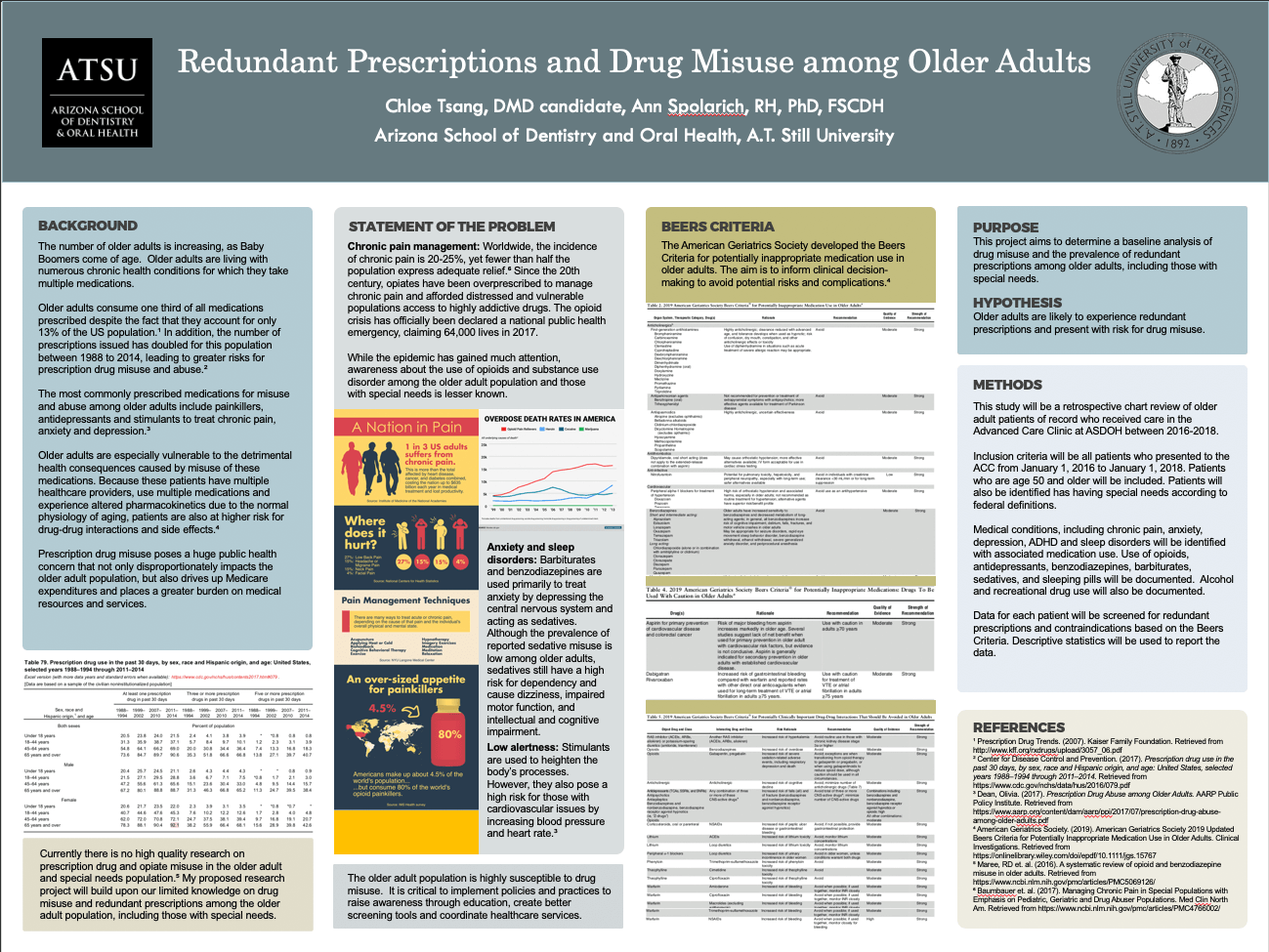Discover Redundant Prescriptions and Drug Misuse Among Older Adults
Contributors:
Chloe Tsang, DMD candidate
Ann Spolarich, RH, PhD, FSCDH
Chloe Tsang, DMD candidate
Ann Spolarich, RH, PhD, FSCDH
Participating Organizations:
Arizona School of Dentistry and Oral Health
Arizona School of Dentistry and Oral Health
Background
The number of older adults is increasing, as Baby Boomers come of age. Older adults are living with numerous chronic health conditions for which they take multiple medications. Older adults consume one third of all medications prescribed despite the fact that they account for only 13% of the US population.¹ In addition, the number of prescriptions issued has doubled for this population between 1988 to 2014, leading to greater risks for prescription drug misuse and abuse.² The most commonly prescribed medications for misuse and abuse among older adults include painkillers, antidepressants and stimulants to treat chronic pain, anxiety and depression.³ Older adults are especially vulnerable to the detrimental health consequences caused by misuse of these medications. Because these patients have multiple healthcare providers, use multiple medications and experience altered pharmacokinetics due to the normal physiology of aging, patients are also at higher risk for drug-drug interactions and side effects.⁴ Prescription drug misuse poses a huge public health concern that not only disproportionately impacts the older adult population, but also drives up Medicare expenditures and places a greater burden on medical resources and services.
The number of older adults is increasing, as Baby Boomers come of age. Older adults are living with numerous chronic health conditions for which they take multiple medications. Older adults consume one third of all medications prescribed despite the fact that they account for only 13% of the US population.¹ In addition, the number of prescriptions issued has doubled for this population between 1988 to 2014, leading to greater risks for prescription drug misuse and abuse.² The most commonly prescribed medications for misuse and abuse among older adults include painkillers, antidepressants and stimulants to treat chronic pain, anxiety and depression.³ Older adults are especially vulnerable to the detrimental health consequences caused by misuse of these medications. Because these patients have multiple healthcare providers, use multiple medications and experience altered pharmacokinetics due to the normal physiology of aging, patients are also at higher risk for drug-drug interactions and side effects.⁴ Prescription drug misuse poses a huge public health concern that not only disproportionately impacts the older adult population, but also drives up Medicare expenditures and places a greater burden on medical resources and services.
Purpose
This project aims to determine a baseline analysis of drug misuse and the prevalence of redundant prescriptions among older adults, including those with special needs.
This project aims to determine a baseline analysis of drug misuse and the prevalence of redundant prescriptions among older adults, including those with special needs.
Hypothesis
Older adults are likely to experience redundant prescriptions and present with risk for drug misuse.
Older adults are likely to experience redundant prescriptions and present with risk for drug misuse.
Methods
This study will be a retrospective chart review of older adult patients of record who received care in the Advanced Care Clinic at ASDOH between 2016-2018. Inclusion criteria will be all patients who presented to the ACC from January 1, 2016 to January 1, 2018. Patients who are age 50 and older will be included. Patients will also be identified has having special needs according to federal definitions. Medical conditions, including chronic pain, anxiety, depression, ADHD and sleep disorders will be identified with associated medication use. Use of opioids, antidepressants, benzodiazepines, barbiturates, sedatives, and sleeping pills will be documented. Alcohol and recreational drug use will also be documented. Data for each patient will be screened for redundant prescriptions and contraindications based on the Beers Criteria. Descriptive statistics will be used to report the data.
This study will be a retrospective chart review of older adult patients of record who received care in the Advanced Care Clinic at ASDOH between 2016-2018. Inclusion criteria will be all patients who presented to the ACC from January 1, 2016 to January 1, 2018. Patients who are age 50 and older will be included. Patients will also be identified has having special needs according to federal definitions. Medical conditions, including chronic pain, anxiety, depression, ADHD and sleep disorders will be identified with associated medication use. Use of opioids, antidepressants, benzodiazepines, barbiturates, sedatives, and sleeping pills will be documented. Alcohol and recreational drug use will also be documented. Data for each patient will be screened for redundant prescriptions and contraindications based on the Beers Criteria. Descriptive statistics will be used to report the data.
